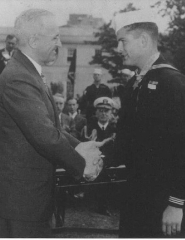Bob Bush

Bob Bush
BOB
BUSH
SOLDIER DETAILS
BIOGRAPHY
Bob Bush enlisted in the Navy at age 17,before completing High School. He did not want to wait until his 18th birthday and be drafted. Bush took his basis training in Faragutt Idaho. On February 10, 1945, he was assigned to Headquarters Company, 2nd Battalion, 5th Marines, 1st Marine Division. Later, he was assigned to G Company, 2nd Battalion, 5th Marines during the invasion of Okinawa.
Bush talks about his position. "A Navy medic could be trained well enough to — service combat Marines in World War II, it took about a year. And the procedure was you’d go through hospital Corps school first and then you would transfer to intern at a Naval hospital some place in the country. Mine was Naval Hospital, Seattle. During my stay there, you would spend one week in each ward. There was 26 wards so you’d have 26 weeks. If any ward you couldn’t pick up on what’s going on in that ward, then you stayed for a second week. At the end of that period, you were selected either for sea duty or for the Marine Corps duty. I was selected for Marine Corps duty and then transferred to Camp Pendleton at Oceanside, California where we went to field medical service school. And at that school we learned how to fire weapons and how to treat people under battle conditions and you stayed there till you got that. And then on your 18th birthday, you shipped overseas. There was a very heavy shortage of medical support for the Marine Corps during World War II because of the many battles going on in the South Pacific. I shipped out of San Diego and went to Pavuvu in the Russell Islands where we staged an invasion coming off an invasion of Peleilu and then staged the invasion of Okinawa. After the training completed, they put us on a LST, that’s a little landing ship that carries 500 Marines and armored amphibious tractors and the bow doors open and the tractors go out and they turn in circles and then they make the invasion. Well, during this training on Guadalcanal, we would do it over and over and over, seven days a week, until we got it down to when our turn came up, that our landing craft would hit the beach and then we’re on our own. We had — at that point in time I had been assigned one platoon, 58 men, to keep healthy. And my mission was to keep as many men and as many guns going as long a time as possible. This decision-making process for an 18-year-old Navy Corpsman, you would think might be kind of difficult, but it really wasn’t. It was, if they were able to fight, they stayed, and if they weren’t, they went back to the rear. The landing craft is called an LST, ours was Number 950, and it left from Pavuvu in the Russell Islands and — and drove all the way to Okinawa, which is six weeks at sea, and maneuvering around other, you were trying to get together where you could become part of the 1,700 ships it took to invade that island. And our particular ship happened to be the first wave. And our armored amphibious tractor happened to be the first one. And the 32 days that I spent on that island, I don’t recall anybody being in front of us. Our unit was an assault unit, the division, the First Marine Division, was assigned as completely expendable, so that we knew we were in deep trouble there. Our mission was to invade this island and secure it, but we were just one little spoke in a great big wheel of 1,700 ships and we had 80,000 men. We spent 20,000 men on the first day to get them ashore. And then from then on we cut the island in half then we started invading toward the south. It lasted 32 days on the island.
On May 2, 1945 in Okinawa, Bush cared for a downed soldier, however the enemy were moving forward where he was tending his patient. Braving the fury of artillery, mortar, and machinegun fire, Bush maintained his position, doing his job, even after sustaining injury.
Bush was presented the Medal of Honor by President Harry S. Truman on October 5, 1945, for his heroic actions on May 2, 1945 on Okinawa. His citation is attached. Courtesy of Frontlines.com and Tom Brokaw book: The Greatest Generation
 Eisenhower Foundation
Eisenhower Foundation
